Days, sometimes weeks, before a luna moth hatches from its cocoon, it starts to move within its winter shell. Quiet bursts of rustling accompany the cocoon’s sporadic movements. Eventually, the cocoon begins to shimmy and roll and the sounds escalate toward agitated scratching as the moth works to cut its way out. Then, suddenly, there it is – all white, fuzzy abdomen and sprawling, fern-like antennae. On stilted brown legs it climbs to reach an adequate height, then slowly unfurls its pale green wings and floats into the night sky.
Lucy Golden has seen luna moths enter the world hundreds of times, along with their giant silk moth cousins: polyphemus, promethea, and cecropia. Golden has been raising silk moths for six years from her small house on a 350-acre farm in Franconia, New Hampshire. A keen observer of the world around her, Golden never outgrew her childhood wonder of the natural world. The dust etched into the lines of her hands hints at much time spent outdoors.
Each May, Golden reaches into her project ’fridge, past the year’s stores of foraged mushrooms and soon-to-be-planted gladiola bulbs, and pulls out four small plastic boxes. Each holds about 50 leaf-wrapped cocoons – one box for each species of giant silk moth native to the northern New Hampshire forest.
Golden started raising the large, showy moths after noticing an alarming drop in the number of cocoons in her backyard. “We used to find the tree-borne cocoons of the cecropia and the promethea in the winter when we were cross-country skiing,” she said. “We’d bring them home and tie them in the appropriate [food source] trees around the yard. We would find easily over 100 cocoons, usually closer to 150 or more. Then, about six years ago, there were noticeably fewer cocoons, and the ones we did find had a very low hatch rate. When I opened the unhatched cocoons, they had clearly been parasitized.”
Parasites aren’t unusual for eastern silk moths – there are nearly 100 natural parasites that affect the 24 species of silk moths this side of the Mississippi River – but the sudden decline in cocoons close to her home made Golden wonder what could be causing such a seemingly abrupt change.
Turning to books and Internet searches, she learned that silk moths, like honeybees, like moose, are declining throughout the region based on a host of factors. The most troubling threat may be a non-native parasitic tachinid fly – Compsilura concinnata.
Golden sought a way to help the moths; thus, a new hobby was born.
Biological Control Gone Wrong
The process of manufacturing silk was developed thousands of years ago in Asia, using silkworms (Bombyx mori) native to that region. In the late 1860s, non-native gypsy moths were brought to Medford, Massachussetts, in an attempt to crossbreed them with Bombyx mori and produce silk. The attempt failed, as have others to develop a commercial silk industry using other species, including Saturniid moths.
The gypsy moths in Medford escaped and were soon devouring forest canopies throughout the Northeast. In an attempt to fight fire with fire, or more accurately plague with plague, the U.S. Department of Agriculture introduced C. concinnata to the region in 1906 in hopes that it would stop the spread of gypsy moth and a handful of other introduced species. It didn’t work. The gypsy moth continued to spread, and C. concinnata began wreaking its own brand of havoc on unintended targets, hitting some 200 species of moths and butterflies, including the giant silk moths native to the Northeast.
More than a century later, gypsy moths are largely under control, thanks in large part to an introduced fungus that kills gypsy moth caterpillars. And C. concinnata has had some success controlling non-desirable moth species, like browntail moth. It remains a threat, however, to dozens of native species, including giant silk moths.
Silk moth caterpillars evolved alongside native parasites, and have natural defenses to combat home-grown parasitic attacks. The caterpillars shed their skin five times as they progress toward adulthood. Because native parasites lay their eggs on a caterpillar’s surface, this molting allows caterpillars to slough off the eggs. Native parasite and host can co-exist – the predation allows the parasite to survive and keeps the host’s population in check. If the parasite is too successful, it wipes out its host and will subsequently also perish.
C. concinnata doesn’t play by the same rules. It does not specialize on one species; rather, it attacks whatever is convenient. And its method of parasitism is considerably more destructive. “The female [C. concinnata] pre-hatches an egg in her oviduct and stabs the caterpillar to insert a maggot,” said George Boettner, a wildlife biologist with the Department of Ecological Conservation at UMass-Amherst. “This maggot basically eats the host alive, saving the vital organs for last. Our native silk moths have no defense against this behavior.”
C. concinnata can produce four generations in one year, and its life cycle is not synchronous with any one moth. That means the fly can build up its population on gypsy moth caterpillars in early summer, and then transition to silk moth caterpillars later, after the gypsy moths have pupated. This makes silk moth caterpillars easy targets at a time when the fly’s populations are peaking.
Boettner has studied the effects of C. concinnata on native silk moths in Massachusetts, coastal Maine, and southern New Hampshire, and found that the introduced fly is devastating the moths in each area. Other biologists have conducted similar studies, with similar results, as far south as Virginia.
Like any species, silk moths experience population fluctuations from predators, diseases, and weather, as well as parasites. “It’s really hard to sort out the most important agents with so much going on,” said Boettner. “But the [decline] I saw in silk moths is from a new introduced species that adds a major agent to an already busy system. The numbers I saw could cause a collapse of this system.”
A Winged Hobby: Making Small Differences
When Lucy Golden stopped finding cocoons hanging in the trees around her home, she started buying them online from Bill Oehkle. A retired teacher, Oehkle raises a variety of native silk moths and sells them from his home in Prince Edward Island, Canada. He sells upwards of 3,000 cocoons and caterpillars each year to customers throughout North America and abroad. In addition to hobby moth raisers, he supplies science museums and researchers, including Boettner.
“When we first ordered cocoons from Bill Oelhke, it was simply to perpetuate what had become our tradition – the thrill of seeing newly hatched moths and keeping track of them,” said Golden. The hobby grew, as hobbies are wont to do.
By the summer solstice, Golden’s crop of silk moths will be in various stages of development. There may be a female promethea or two in the mating cage hung by the back door, waiting for nightfall and the hopeful arrival of a male suitor. A recently mated polyphemus may be laying eggs in another container. A box of luna caterpillars in the first instar may be noshing birch leaves. Larger caterpillars, two or three weeks old, may have already been placed on their host trees – usually black birch or scrub cherry – with large branches wrapped in remay to keep the caterpillars safe from parasites and predators.
The caterpillars change drastically through their five instars. Each species is different, but all sport spiky protrusions as smaller caterpillars, along with a variety of spots and stripes. These become more colorful as the caterpillars progress, and by the third instar, cecropia larvae are particularly vibrant, dotted with bright red, sky blue, and yellow protrusions topped with black points. By the fifth and final instar, the caterpillars have grown into their spikes and look, in Golden’s words, “like space alien cucumbers.”
Just raising so many Saturniids – from newly hatched moths, to eggs, to tiny caterpillars that will eventually grow as long and thick as a large man’s index finger, to cocoons that are collected in late summer and stored through the winter to start the cycle again – could be a full time job. For Lucy Golden it is simply part of an annual routine. But it’s a routine that has taken some adjustment, both emotionally and logistically.
“I had a difficult time with this when we first started,” she said. “I felt that containing these glorious moths was the antithesis of what they represented. Somehow I got over it, perhaps because I would like to believe that it is ultimately in the best interest of these moths to have a little hand up here and there.”
Each season brings its own challenges, which Golden tackles as they arise. The first year, a bear ripped through the remay bags, and Golden discovered eggs, likely from a native parasite, on the caterpillars. These she painstakingly picked off, one by one, with tweezers. Another year, blue jays devoured her newly hatched luna moths. When Hurricane Irene raged through the region in 2011, Golden worried the winds would blow the remay bags off the trees. She collected the caterpillars – all 150 of them – along with their feeding branches and brought them inside until the weather cleared.
Raising the giant silk moths, which by their sheer beauty inspire wonder in anyone who glimpses one clinging to a tree at dusk, or hanging near the glow of a porch light, is a marvel Golden now shares with others. Of the 150-200 cocoons she saves each fall, Golden keeps about half. The rest she distributes to friends, families with children, and schools, where students love to watch the giant moths emerge from their winter confinement.
“I believe deeply that having an appreciation of nature is one of its best defenses, and thus one of ours, too,” said Golden. “To provide opportunities for children, or anyone, to witness the magic and glory of the natural world at its best is a small act that may be carried down the road. If it instills a desire to save a caterpillar or a snake or a turtle, or to take steps to care for our environment, then it has made a difference.”
It’s not a matter of what is killing the caterpillars, but a desire to help them, that has inspired Golden to the considerable effort she makes each year. Since she embarked on the annual moth project, Golden has discovered others who are also raising silk moths, releasing them to the wild, hoping to give them a leg, or a wing, up.
Boettner said there are dozens of people in the Northeast raising moths as a hobby, some of them rearing giant silk moths in large numbers. Last year, he heard from moth watchers that it was a good season for silk moths. But there’s no one officially tracking silk moth populations. Nor is there any monitoring of C. concinnata outside of controlled studies.
For Golden, the anecdotal evidence is enough. “I have found more wild cocoons in the past couple of years, but can’t – and don’t even want to – claim that it has anything to do with this project. If these moths are making a comeback, I don’t care why so much, only that they are,” Golden said. “The efforts that people make – they may not make a big difference, but they make a little difference. And those little differences add up.”


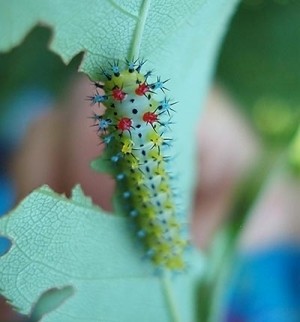
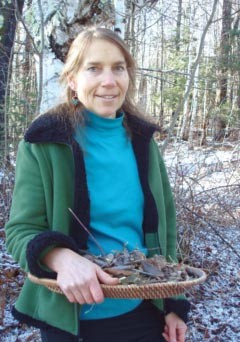
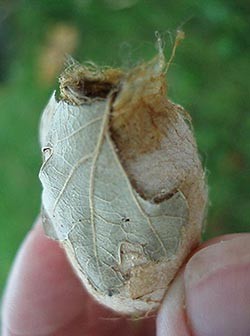
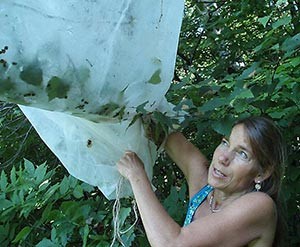
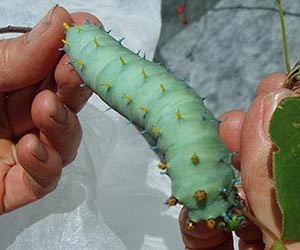
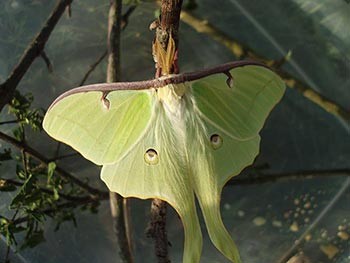
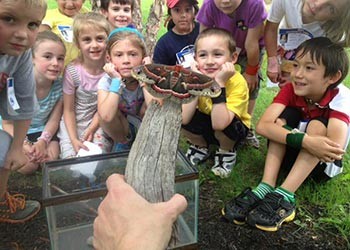
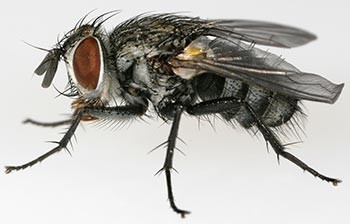
Discussion *